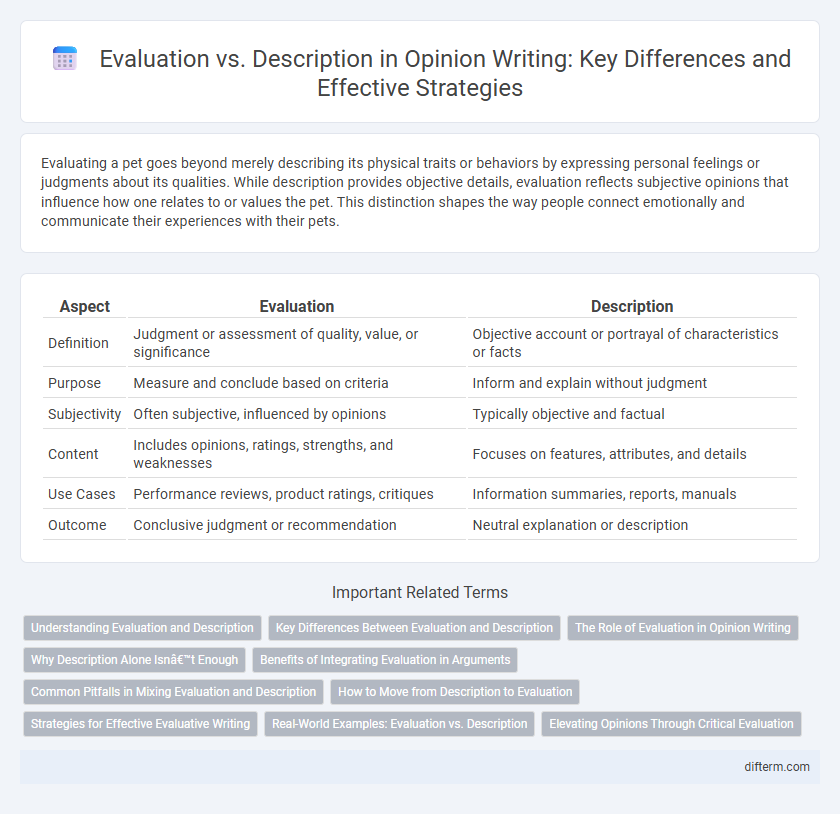Evaluating a pet goes beyond merely describing its physical traits or behaviors by expressing personal feelings or judgments about its qualities. While description provides objective details, evaluation reflects subjective opinions that influence how one relates to or values the pet. This distinction shapes the way people connect emotionally and communicate their experiences with their pets.
Table of Comparison
| Aspect | Evaluation | Description |
|---|---|---|
| Definition | Judgment or assessment of quality, value, or significance | Objective account or portrayal of characteristics or facts |
| Purpose | Measure and conclude based on criteria | Inform and explain without judgment |
| Subjectivity | Often subjective, influenced by opinions | Typically objective and factual |
| Content | Includes opinions, ratings, strengths, and weaknesses | Focuses on features, attributes, and details |
| Use Cases | Performance reviews, product ratings, critiques | Information summaries, reports, manuals |
| Outcome | Conclusive judgment or recommendation | Neutral explanation or description |
Understanding Evaluation and Description
Evaluation involves making judgments based on criteria and personal values, offering a deeper insight into the significance or quality of a subject. Description, on the other hand, focuses on objectively presenting facts, characteristics, and details without expressing opinions or assessments. Understanding evaluation requires recognizing the subjective nature of judgments, while description demands attention to accurate and comprehensive reporting of information.
Key Differences Between Evaluation and Description
Evaluation involves making judgments about the quality, value, or significance of a subject based on established criteria, while description focuses on objectively detailing the characteristics or features without personal bias. Key differences include that evaluation requires critical analysis and interpretation, whereas description relies on factual reporting and observation. Evaluation often influences decision-making processes; description serves to inform and provide a clear, neutral account.
The Role of Evaluation in Opinion Writing
Evaluation plays a crucial role in opinion writing by providing a critical lens through which the subject is analyzed and judged, rather than merely described. It allows writers to express their stance clearly, supported by evidence and reasoning that persuade readers and deepen understanding. Unlike description, evaluation adds value by interpreting facts and shaping readers' perspectives through informed judgment.
Why Description Alone Isn’t Enough
Description alone fails to capture the full scope of an experience because it merely presents facts without interpreting their significance or impact. Evaluation provides critical analysis and judgment that helps to understand value, quality, or effectiveness beyond surface-level details. Without evaluation, descriptions risk being shallow and uninformed, lacking the deeper insights necessary for meaningful conclusions.
Benefits of Integrating Evaluation in Arguments
Integrating evaluation in arguments enhances critical thinking by allowing for a deeper analysis of evidence and reasoning, which strengthens the overall persuasiveness. It helps identify biases and logical fallacies, promoting clearer and more credible communication. Including evaluation also facilitates informed decision-making by weighing pros and cons rather than merely describing facts.
Common Pitfalls in Mixing Evaluation and Description
Mixing evaluation and description often leads to blurred distinctions where subjective judgments are presented as objective facts, undermining clarity and credibility. Common pitfalls include using evaluative language within descriptive passages, causing readers to question the reliability of the information. Maintaining clear boundaries ensures accurate interpretation and strengthens argumentative coherence.
How to Move from Description to Evaluation
Transitioning from description to evaluation requires critical analysis that goes beyond merely stating facts to interpreting their significance and impact. Evaluators must apply criteria or standards relevant to the subject area, such as effectiveness, accuracy, or value, to form a judgment. Employing evidence-based reasoning enhances credibility by connecting descriptive details to well-supported assessments that articulate strengths, weaknesses, and implications.
Strategies for Effective Evaluative Writing
Effective evaluative writing prioritizes clear criteria establishment and evidence-based judgments over mere description to enhance critical analysis. Implementing strategies such as defining specific benchmarks, incorporating comparative examples, and acknowledging multiple perspectives strengthens the persuasiveness of assessments. Using precise language that distinguishes evaluation from summary fosters deeper reader engagement and clarity in presenting nuanced opinions.
Real-World Examples: Evaluation vs. Description
Evaluation provides critical judgment based on criteria and standards, such as rating a restaurant's service and food quality, while description merely outlines observable facts, like the menu offerings and decor. In education, evaluation involves assessing student performance against learning objectives, whereas description records attendance or participation without judgment. These distinctions highlight how evaluation drives decision-making and improvement by interpreting data, contrasting with the neutral reporting of description.
Elevating Opinions Through Critical Evaluation
Critical evaluation elevates opinions by moving beyond surface-level description to analyze underlying meaning, implications, and value. It engages with evidence, contexts, and diverse perspectives, providing a richer and more persuasive understanding. This depth transforms opinions from mere statements into thoughtful arguments that foster informed discourse.
evaluation vs description Infographic

 difterm.com
difterm.com